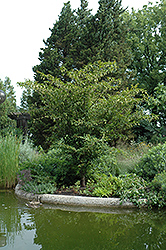Height: 25 feet
Spread: 20 feet
Sunlight:
![]()
![]()
![]()
Hardiness Zone: 5a
Description:
A small shade tree remotely related to the birch with narrow leaves and a tidy, wide-spreading habit of growth, a distinctive and uncommon tree for smaller home yards
Ornamental Features
The Japanese Hornbeam has emerald green deciduous foliage on a tree with a round habit of growth. The pointy leaves do not develop any appreciable fall colour. It produces small clusters of green hop-like fruit from early fall to late winter.
Landscape Attributes
The Japanese Hornbeam is a deciduous tree with a more or less rounded form. Its average texture blends into the landscape, but can be balanced by one or two finer or coarser trees or shrubs for an effective composition.
This is a relatively low maintenance tree, and is best pruned in late winter once the threat of extreme cold has passed. It has no significant negative characteristics.
The Japanese Hornbeam is recommended for the following landscape applications;
- Accent
- Shade
- Mass Planting
- Hedges/Screening
Planting & Growing
The Japanese Hornbeam will grow to be about 25 feet tall at maturity, with a spread of 20 feet. It has a low canopy with a typical clearance of 3 feet from the ground, and is suitable for planting under power lines. It grows at a slow rate, and under ideal conditions can be expected to live for 60 years or more.
This tree performs well in both full sun and full shade. It is quite adaptable, prefering to grow in average to wet conditions, and will even tolerate some standing water. It is not particular as to soil type or pH. It is somewhat tolerant of urban pollution. This species is not originally from North America.
Disclaimer - This resource is provided for informational purposes only and does NOT reflect current availability. Inventory varies seasonally, so we cannot guarantee that every plant will be in stock at all times - please contact your favourite GardenWorks location directly for current availability. It does not include our entire inventory of plants, so be sure to visit GardenWorks to see varieties that may not be represented on this list.

